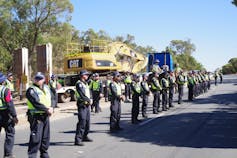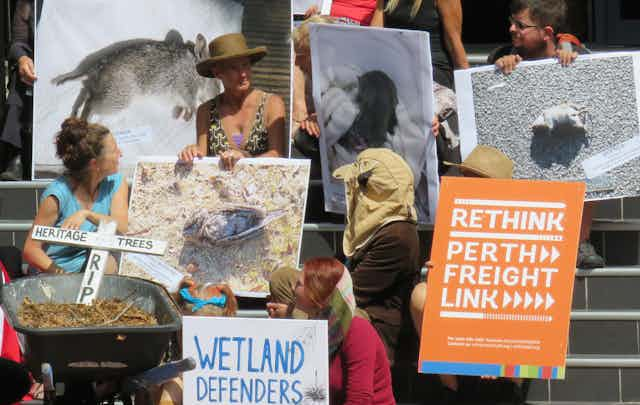Here in Perth, a battle is raging over a 5km stretch of road known as Roe 8. Work on the project, part of the proposed Perth Freight Link, began late in 2016 and as legal avenues to halt construction were exhausted, opponents resorted to non-violent direct action. Some protest “mass actions” have attracted more than 1,000 people from all walks of life and by the end of January, as bulldozers tore through the Coolbellup bushland under costly police protection, well over 100 had been arrested.

Proponents say the road is necessary to improve the safety and efficiency of freight traffic to and from the Port of Fremantle. Opponents point to freight alternatives that will avoid Roe 8’s destruction of Aboriginal heritage, endangered banksia woodland, and important wetlands. Critics have also decried the government’s lack of transparency and prudence in decision-making, and highlighted serious shortcomings in environmental policies and laws.
The state’s Labor opposition has promised to scrap the project if it wins government at the state election on March 11, yet to the shock and dismay of many, bulldozing continues.
How will the conflict end? While history provides no sure guide to the future, it does reveal that successful environmental campaigns have tended to share several key features that unsuccessful campaigns have lacked. What are they?
1. Elections
Some of the biggest environmentalist victories have been won at the ballot box. This was the case for the proposed Franklin River dam, which became a federal election issue and helped to bring Bob Hawke’s Labor government to power.
By-elections have also decided the fate of environmentally contentious developments. Wayne Goss’s proposed “Koala tollway” between Brisbane and the Gold Coast cost Labor nine seats in the 1995 state election; a by-election in February 1996 saw the end of both Goss’s majority and the toll road.
Similarly, the campaign against a proposal for agricultural development in Victoria’s Little Desert delivered a shock metropolitan by-election result that, along with sustained public pressure, quashed the proposal.
More recently, the East-West Link toll road in Melbourne was, like Roe 8, hurried into the construction phase before an election with no full business case available for public scrutiny. The campaign against the Link, which united public transport advocates and local councils, ran for more than a year and attracted A$1.6 million in policing costs. Labor promised to halt construction and following his electoral success in November 2015, the incoming premier Daniel Andrews tore up the contracts, setting what might turn out to be a crucial precedent for WA Labor’s Mark McGowan.
Even electoral failures can help environmental causes in the long run. Advocates for Lake Pedder in Tasmania didn’t attract political support for their cause from either major party, so they formed their own: the United Tasmania Group. It narrowly failed to win a seat at the 1972 state election, and Lake Pedder was lost.
But those who were galvanised by this failure were instrumental in the victory 10 years later over the Franklin dam, which transformed federal-state relations and launched the Australian Greens as a political force.
2. Unions
Many past environmental campaigns have succeeded only through union involvement. In the 1970s and ‘80s, almost 50% of the Australian workforce was unionised, giving the unions significant power to shut down contentious projects.
The 1970 campaign against oil drilling on the Great Barrier Reef claimed success when the Transport Workers Union and affiliates placed a black ban on drilling vessels in the region. The 1970s “Green bans”, led by Jack Mundey and the NSW Builders’ Labourers Federation, blocked a range of threats to heritage sites and bushland, including urban bushland at Kelly’s Bush on Sydney’s lower North Shore.
With union membership today at only around 15%, and the environment a low priority for some key unions, this opportunity for intervention has all but vanished.
3. Alternatives
Campaigns are more likely to be successful where environmentalists can point to viable alternatives for the projects they oppose. For example, opponents of woodchipping in East Gippsland in the 1980s produced a report showing how developing agriculture and tourism in parallel with a restructured and modernised timber industry would produce 450 extra jobs in the region.
This material was then used in political lobbying, as well as campaigning in marginal seats, leading to the declaration of the Errinundra Plateau and Rodger River National Parks in 1987. Logging continues, however, in adjacent areas.
Similarly, Citizens Against Route Twenty achieved success in 1990 with an intense media campaign that included an alternative vision for Brisbane’s urban transport.
Back to Roe 8
In sprawling suburban Perth, the track record of opposition to new roads does not inspire much hope for those campaigning against Roe 8. Previous protests against the Kwinana Freeway, the Graham Farmer Freeway and the Farrington Road extension were all more or less futile.
In each case the opponents were deemed to be “anti-progress”, with progress implicitly represented by the construction of new road infrastructure. Similar language pervades the current rhetoric around Roe 8, which is portrayed by supporters as a solution to all the traffic problems of Perth’s southern suburbs.
Sustainable transport advocates take a longer view; for instance, in the alternative plan laid out by Curtin University’s Peter Newman and Cole Hendrigan. This, however, has been rejected by the Barnett government in favour of the Roe Highway extension, which was originally planned for different purposes in the 1950s.
The protest against Roe 8 has two of the three key historical ingredients for success (an election, and a clearly outlined alternative plan). It has also harnessed the new power of social media and drone footage.

Rarely has direct action clinched an environmental campaign, although there are precedents: protesters’ destruction of felled timber at Terania Creek in 1979 brought an end to logging. Tree-sitting and human barricades bought enough time for political change to halt the Cape Tribulation-Bloomfield Road in Queensland’s Wet Tropics. In Coolbellup numerous lock-ons and tree-sits have delayed works, but time is running out for the wetlands in the path of Roe 8.
After the March 11 election we will know whether the already bulldozed area will be restored, or whether the road will be built. Whatever the outcome, one thing is certain: pressure is building on resources and urban spaces, and the indicators of environmental health are continuing to decline.
This trend makes it ever more likely that our economic and political priorities will find themselves on a collision course with communities seeking to protect their local environments. It seems safe to say that we will see plenty more protests like this in coming years.

